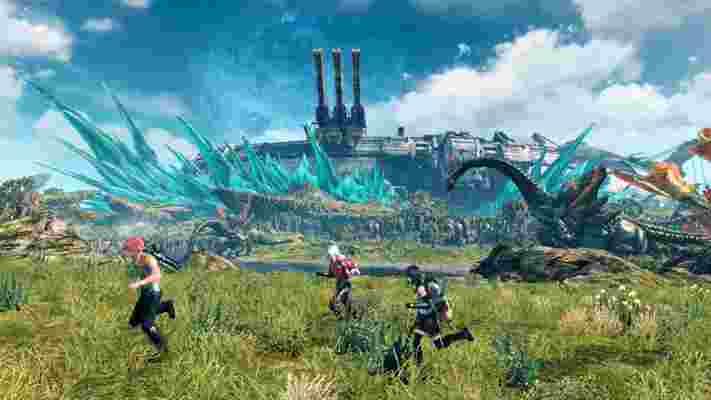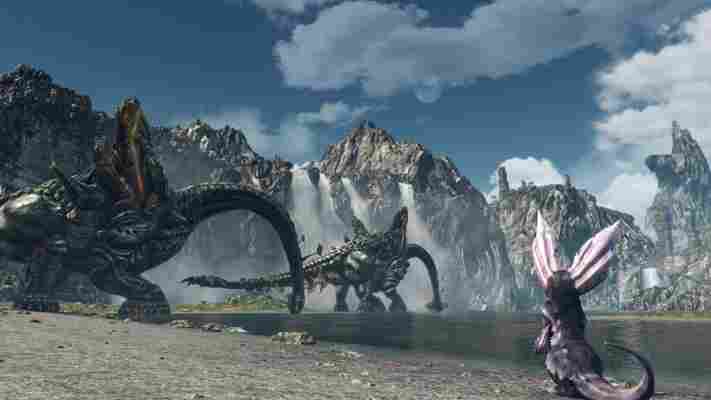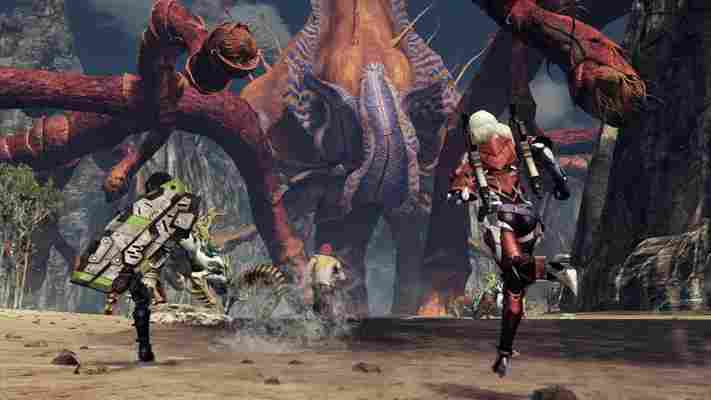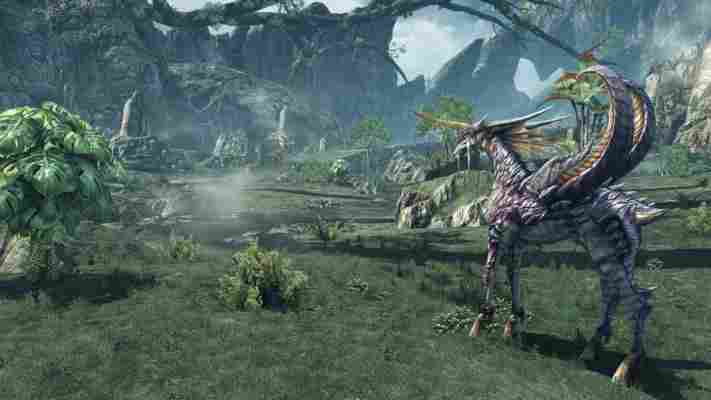Japanese RPGs have rather fallen out of favour in recent years. Once the defining genre of the late 90s and early 2000s, JRPGs only seem to have grown more complex in the intervening generations, relying on intricate systems and knotty skills tables to prop up their increasingly rigid story lines and clichéd anime characters – Final Fantasy XIII, I'm looking at you. It's certainly a far cry from the Fallout 4 s and Witcher 3 s that have dominated western RPGs this year, but thankfully this is all slowly starting to change thanks to Monolith Soft's revolutionary Xenoblade series.

That might seem odd considering this is the same team that made the famously incoherent Xenosaga trilogy, but the Wii's Xenoblade Chronicles (and its 3D remake on the New 3DS ) kept things simple. Death didn't mean the loss of hours of progress, your party healed automatically after each fight, effectively eliminating the need for copious healing items, you were rewarded with experience and battle points when you discovered new locations, and its setting – the bodies of two colossal gods – was unlike anything else I'd seen before. It was a place of such consistent wonder that it practically demanded you explore every last corner of its huge, seemingly unending world, even if it meant diving into a den of level 70 spiders or throwing yourself off a massive waterfall just to see what was at the bottom.

Xenoblade Chronicles X, its entirely unrelated sequel for the Wii U, still channels a lot of the same philosophy, but it does so from a distance, occasionally lapsing back into the bad habits that made its genre so impenetrable in the first place. Its battle system, for instance, needs a thorough read of the in-game manual before you can even begin to master its secrets, exploration is bogged down by the tedious chore of planting data probes to permanently expand your map, and quests now feed into a larger system of military divisions and rewards. The more quests you complete belonging to the division you currently associated with, for instance, the more points you earn for your collective online community and the greater variety of rewards you can collect at the end of the day.
There's also something distinctly cold and indifferent in how Xenoblade Chronicles X frames your purpose in this world. Instead of playing as a rag-tag band of warm, well-written characters on a quest for revenge, X casts you as nothing more than a mute, customisable avatar which gets dragged in by a faceless military organisation to protect the last remnants of mankind when you crash land on the strange alien planet of Mira. You might have set companions which follow you on your journey, but they're nowhere near as interesting or multi-faceted as the crew of the original Xenoblade. Without that drive and core sense of identity, X's narrative can occasionally feel a little thin at times, and when you can't start a new story chapter just because you haven't ticked enough probe boxes on your map, X falls dangerously close to becoming just as irksome as its contemporaries.

Luckily, Xenoblade Chronicles X has a secret weapon: Mira. Here, you'll find 200ft space dinosaurs lapping peacefully at vast, ocean-like watering holes, bioluminescent whales soaring through huge, bottomless desert canyons, and six-armed apes prowling overgrown forests of such magnitude that you wonder how the Wii U could ever produce such stunningly seamless landscapes. Monolith Soft has once again outdone itself with the world of Xenoblade Chronicles X, and the incredible craftsmanship of its new playground is more than enough to help smooth over any flaws I have with its somewhat clinical storyline.
Not that Mira is a particularly friendly place for humans, as this savage planet is rife with monsters looking to put mankind on its ever-growing extinction list – including the warring clans of aliens who forced you to flee Earth and crash land on this strange new world in the first place. Still, if the human race is going down, then what better place to fight for survival than under the glowing trees of Mira's Noctilum or the dusty steppes of Oblivia.

It's a world that constantly amazes with each passing corner, and while Monolith Soft has downsized the number of main area hubs to just six in X (the original Xenoblade had over twenty), the sheer size of them actually adds up to a map that's over four times the size overall. It's a truly huge and delightful place to get lost in, and its dense ecosystem of creatures only reinforces just how small you are, and how little control you have over its vibrant populace.
Each area is handily mapped right on to your GamePad screen, making it easy to keep track of where you're going and where your next objective lies. More often than not, though, you'll be staring at the TV trying to work out your route, as the map does little to account for Mira's cavernous valleys and steep cliffs. You do have a rather generous space jump that helps you traverse the occasional sheer mountain face, but when you're faced with a 100ft waterfall, there's not much you can do except go the long way round.
A better gradient scale would be useful, then, but picking your way across these vast landscapes by sight alone does make the process of discovery all the more enjoyable. This isn't just somewhere you can walk in a straight line and end up at your destination. This is a place that absolutely requires careful and considering orienteering, and it makes the world feel all the more convincing for it.
Of course, all this changes when you acquire your very own mech robot. You've burned through a fair number of shoe soles by the time they become available, but these mechs, or Skells, open up the borders of Mira like never before, letting you fly to places previously unreachable by foot and, more importantly, providing a more level playing field against Mira's larger inhabitants.
Such freedom does come at a cost, though, and it's here where X comes across as surprisingly mean-spirited. For instance, those whales that once completely ignored you on the ground now take renewed interest in your new metallic form, and scrapping with monsters out of your league can lead to a surprisingly quick explosion of your new robotic plaything. It wouldn't be so bad if they weren't so eye-wateringly expensive to maintain and buy new parts for, but with resources being so scarce, all repairs cost more than your average box flat on the outskirts of London.
Still, while Skell combat is wonderfully over the top, it's the action down on the ground where Xenoblade Chronicles X really shines. Like the original Xenoblade, positional attacks still play a huge role in determining how much damage you deal, but now you land even bigger hits by responding to your team's cries for help. These 'Soul Voice' moments are X's biggest asset, as it turns each scrap into a dynamic dance of call and response as you react to each other's movesets, demanding your utmost attention as you frantically narrow in on those seconds-long windows of opportunity. They're also one of the only ways of healing your ailing party members, as dedicated healing attacks are few and far between.
All that might sound complicated, but in action it's one of the most fluid and engaging combat systems I've seen across the genre. The addition of ranged and close quarters combat also brings with it its own unique rhythm, as you can change your play style on the fly with a simple tap of a button. Likewise, X's new Monster Hunter -inspired targeting system lets you lob off specific body parts to disable attacks and gain extra loot and items at the end of each battle. It goes one better than Capcom's carve-athon, too, as each appendage has its own health bar to let you know exactly how close you are to delivering that fatal blow, adding even more opportunity for a strategic comeback if you happen to find yourself in trouble.
You don't necessarily have to go out adventuring with your pre-set companions either, as you can also team up with up to three other players online or form a party with your friends to tackle larger, more dangerous monsters. You'll find other players' avatars scattered round the map, too, which you can scout into your squad for a short time as an extra AI-controlled party member. The fact it all works seamlessly is just another testament to Monolith's impressive world building.
In the end, it doesn't really matter that Xenoblade Chronicles X isn't quite as narratively charming as its hallowed predecessor. It might not have the same simple vision as Monolith's Wii stunner, but all its stuffy rigmarole does work to serve the game world at large, both online and when you're playing alone. Likewise, when there's such immense satisfaction to be gained from its rich, boundless landscape, whether it's cresting a towering mountain and watching the sun set as an Aurora Borealis begins to twinkle in the sky, or getting down and dirty with its local wildlife, Xenoblade Chronicles X is a true wonder from start to finish. It once again sets the bar for open world JPRGs everywhere, and it's easily the best game you'll find on Wii U this year. It wins a Best Buy award.
| Availability | |
|---|---|
| Available formats | Wii U |
| Buying Information | |
| Price including VAT | £40 |
| Supplier | www.game.co.uk |
| Details | www.nintendo.co.uk |
